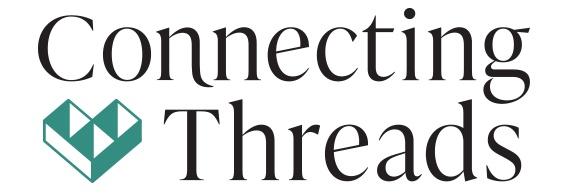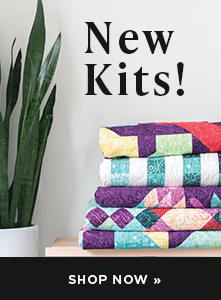A Guide to Batting
Batting (or “wadding” for our Australian friends) is a layer of insulation used in quilting between a top layer of patchwork and a bottom layer of backing material.
How do you decide which one to use for which project? There are many different brands and blends, and I could go on forever about them, but I’ll just cover the main ones here.
First we will go over some terms often heard when referring to batting:
Bearding (AKA “migration”): When the fibers separate and start working their way through the weave of the fabric, escaping the quilt.
Drape: How a quilt feels and hangs after being quilted. Good batting will allow your quilt to drape without being too stiff.
Loft: This refers to the thickness/puffiness of the batting. Cotton is generally low-loft, but it is available in several different thicknesses so you can find higher loft cotton batting. Polyester is generally high-loft.
Low-loft batting is easy to needle and handle, and is soft and drape-able. Medium-loft batting adds texture, gives a puffier look, and is warmer, but the higher the loft the harder to machine and hand quilt. High-loft batting is good for highlighting detailed quilting and mimics the look of down, and it is also often used in tied quilts
Batting is often constructed of different types of fibers held together using a variety of methods, so that it does not clump within the quilt or break apart.
These are the most common methods for holding the fibers together:
Bonded: The fibers are bonded together by either thermal or resin method. Thermal bonding has a low melt fiber blended with standard polyester to hold it together. This can allow bearding but doesn’t break down with washing and dry cleaning as fast as resin bonded batting. Resin bonded batting is made from a variety of fibers including polyester, cotton, and wool. Resin is applied to both sides then dried and cured. This makes it resist bearding better than any other batting.
Needle-punched: The fibers in the batting are mechanically felted together by punching them with thousands of tiny needles. This causes the batting to be stronger and denser while being lower loft. Because of the denseness, this batting it isn’t generally good for hand quilting. These battings will tend to migrate but will not bunch and shift. Needle-punched batting can be thermal or resin bonded.
Scrim: A thin stabilizer that is needle-punched into the batting to add strength, loft, and to prevent stretching and distorting.
The most often used fibers for battings are cotton, polyester, wool, and blends, although bamboo is becoming more commonplace.
Here are some differences, good and bad, for each:
Cotton: Cotton is soft, breathable, and a natural fiber that can usually be found in several different lofts. It is machine washable and dry-able, has good drape and ages well. It softens, wrinkles, and shrinks with washing giving it a “lived in” look. It’s the choice of quilters looking to make heirloom quilts that will stand the test of time. The low loft makes this great for anything you want to be flat such as place mats, table runners, bags, etc. You can get cotton batting with scrim which gives it more loft, similar to polyester.
Polyester: Usually has good drape and has the most loft, so it can make the quilting stand out, and as a side benefit makes it cozy. It retains its shape no matter how many times washed and is lighter than cotton. It doesn’t breathe like cotton and can beard. This is great for baby quilts and lap quilts that will be repeatedly washed and is usually the most economically priced option. The higher loft also makes it a good choice for wall hangings and dimensional projects.
Wool: Great drape, regulates body temperature (warm and moisture-wicking), and is very strong. Good for both machine and hand quilting. No scrim or resins. You have to be very careful when laundering quilts made with wool batting because if you don’t follow instructions and wash it in warm water or dry it then you will end up with felted clumps in your quilt instead of nice flat batting. Wool is generally a higher price point than other options. Great for bed quilts and quilted jackets or anything you want to be extra warm.
Blends: These are usually cotton and polyester blended together in an 80/20 or 70/30 configuration but I have seen bamboo and silk blends as well. Long arm quilters tend to love the cotton/poly blend as they combine the easy handling of cotton but add some loftiness of polyester to make the quilting stand out better. This is usually a similar price as cotton batting.
Bamboo: The most common bamboo batting I have seen is a blend of 50/50 organic cotton and bamboo. It’s very soft with great drape, and it’s good for hand and machine quilting. A side benefit of this batting is that bamboo is naturally antibacterial. It can tend to beard, so don’t use it with dark fabrics.
For darker fabrics, I would recommend using black batting to solve any issues of white batting showing through.
Other kinds of batting and batting accessories:
Fusible Batting: You can buy batting that already has fusible applied so that just by using the iron it temporarily attaches the top, batting, and backing together, rather than having to baste or pin the layers. This is especially great for smaller projects.
Thermore Batting: This is a very thin polyester batting that has been through a process to make it a better insulator. There is no bearding and has ultra low loft so you can make a very thin quilt that is super warm, great for clothing, a travel quilt or a quilt for someone who lives in a cooler climate. It works great for either hand or machine quilting.
Insul-Bright: This is a great product for anything you need heat resistant such as pot holders.
Heat Press Batting Tape: You can piece your leftover batting together using Heat Press Batting Together. You just “tape” the pieces together and press. It’s a cloth tape that fuses the batting edges together. It’s soft and thin enough to hand or machine quilt. This would be a good way to use up leftovers.



 Tutorials
Tutorials

